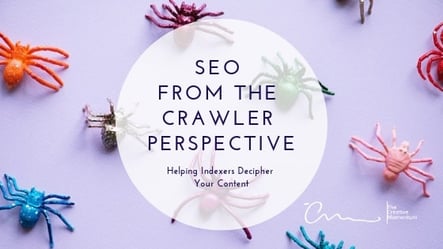
Getting seen by your target audience is no small feat. You're competing with hundreds, if not thousands, of competitors in your industry all vying for the same eyeballs. It's why just having a website up isn't enough, and why SEO is such a vital part of any marketing strategy.
But what good are all your efforts to be seen if Google and other search engines don't even realize you're there?Enter web crawlers and indexing, a basic concept that has surprising depth in application for your site.
Web Crawler 101
First, some basics for the uninitiated. Crawlers are used by a search engine to index websites. They travel across a site and follow the different links on each page, taking note of its content and then creating an entry for each page in the search engine index. Essentially, they map out websites and how pages relate and connect to one another, both internally on a site and throughout the greater web. Imagine a crawler as part inspector, part librarian.
Similar to a card catalog, the index entries created by the crawlers are what the search engine’s algorithms use to gather results.
Why are Web Crawlers Important?
Well, if you want people to find your website easily, then you will have to present the information the user is looking for in a way that is accessible to the crawler. If the crawler doesn’t know that the information is there, then the information doesn’t go into the index entry and will not be factored into the algorithm and be presented in the results. The algorithm can’t calculate information it doesn’t know is there. Here is an in-depth video from Google on how a search engine works. It will help you understand why the information captured by a crawler is so important.
How to Make Information More Accessible for Crawlers
Website architecture and links are very important since this is how a crawler navigates your website. It lands on a page and then moves around, following link to link. A crawler spends only a limited amount of time on the website, so you want to provide a clear and direct path to the information you know your customer is looking for. Make sure that important information isn’t overlooked. Don’t make it difficult for the crawler, or end user, to find information. This is a critical factor to consider when designing or redesigning a website.
-
Make sure that information on similar topics is clustered and linked together both in the navigation bar and in the content of your website. The rule of thumb is this: topics should be no more than four clicks deep.
-
Be wary of orphan pages, i.e. pages that don’t link to other parts of the website. This mostly occurs when different versions of a website are not properly reconciled and linked. Search engines do not like this, and it will adversely impact your SEO.
-
Make sure all links work properly and there are no broken pages.
-
Make sure pages load quickly.
It’s also important not to overlook the importance of external link-building on SEO, which we discussed more in depth here.
Content
Content is another important factor to consider, both what is created and how it’s presented.
SEO is inherently tied to the quality of the content, and providing unique content on a regular basis will help boost your SEO. Crawlers are always looking for new information, so if every time they visit, they find new content, they will come back more often. This means your index entry will be continually updated, and your ranking will be higher. The inverse is also true. If crawlers visit your website and find the same static content, they will visit less frequently, and your ranking will decrease. As you’re planning your website, think of how you will be updating it and adding new content.
However, frequency alone is not enough to boost your SEO. Content and keywords also play an important role since it’s the information that crawlers are actually looking for and indexing. Search engine databases are organized around keywords and phrases, and they retrieve results according to how well those words match. Therefore, be sure you understand what your customers are looking for and how they communicate. For example, is there technical language associated with your product? If there is, make sure to include those words or phrases so they’re picked up by the crawlers. The more precise and customized, the better your ranking and sales leads will be.
Non-Indexable Content
Crawlers will not be able to index everything you put on your site. For example, images, video, PDFs, Flash files and Java applets are difficult for crawlers to handle, but there are ways to work around that.
Some things to consider when working with this type of content:
-
Make sure any content written on an image is also included on the page. For example, if a date and location of an event is on the image, make sure it’s listed as text as well.
-
Use image captions when appropriate
-
Provide alt-text descriptions for images. Make sure it aligns with your keyword strategy. This description will be used by the crawler to index your image.
-
Try any of these tips to make your PDFs SEO friendly
-
Minimize the use of Java applets or replace with HTML links
Title & Meta Description
Writing effective title and meta descriptions can have a significant, positive impact on your SEO. Title tags are short word descriptions of a web page that appear as clickable links on a search engine results page (SERP). Every page of your website has one.
A meta description is a short description of your website that appears below the title-tag on the SERP. Both are used by crawlers when indexing your website and provide opportunities to improve your ranking.
If this seems like a lot of information to consider, that’s because it is. SEO involves managing multiple elements, and any one can have negative impact. Contact us to discuss how our team of SEO experts can help guide you and implement these strategies.


